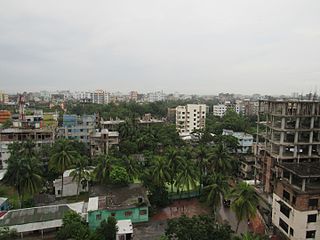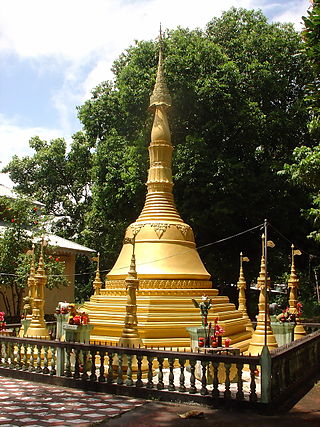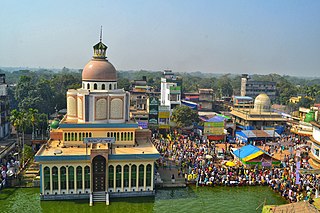Related Research Articles

Cox's Bazar is a district in the Chittagong Division of Bangladesh. It is named after Cox's Bazar town. It is located 150 kilometres (93 mi) south of Chittagong. Cox's Bazar is also known by the names Panowa and Palongkee. The modern Cox's Bazar derives its name from Captain Hiram Cox, an army officer who served in British India. It is one of the fishing ports of Bangladesh, and contains one of the world's longest natural sea beaches.

Comilla District, officially known as Cumilla District, is a district located in southeastern Bangladesh. It lies about 100 kilometres south east of Dhaka. Comilla is bordered by Brahmanbaria and Narayanganj districts to the north, Noakhali and Feni districts to the south, Tripura state of India to the east and Munshiganj and Chandpur districts to the west.

Buddhism is the third-largest religious affiliation and formed about 0.63% of the population of Bangladesh. It is said that Buddha once in his life came to this region of East Bengal to spread his teachings and he was successful in converting the local people to Buddhism, specially in the Chittagong division and later on Pala empire propagate and patronized Buddhist religion throughout the Bengal territory. About 1 million people in Bangladesh adhere to the Theravada school of Buddhism. Over 65% of the Buddhist population is concentrated in the Chittagong Hill Tracts region, where it is the predominant faith of the Rakhine, Chakma, Marma, Tanchangya, other Jumma people and the Barua. The remaining 35% are Bengali Buddhists. Buddhist communities are present in the urban centers of Bangladesh, particularly Chittagong and Dhaka.

Naogaon District is a district in northern Bangladesh, part of the Rajshahi Division. It is named after its headquarters, the city of Naogaon in Naogaon Sadar Upazila.

Chittagong District, renamed the Chattogram District, is a district located in south-eastern Bangladesh. It is a part of the Chittagong Division. The port city of Chittagong, which is the second largest city in Bangladesh, is located within this district.

Barua is a Bengali-speaking Indo-Aryan ethnic group native to Chittagong Division in Bangladesh and Rakhine State in Myanmar, where they are known as the Maramagyi or Maramagri or particularly the Magh Barua. According to Arakanese chronology, the Barua Buddhists have lived there for five thousand years. Another derivation of 'Barua' is 'Baru' and 'Arya' meaning great aryan. They are commonly identified by their last name, "Barua". Barua is derived from "Baru" meaning "great" and "ua", meaning "noble rulers". In Myanmar, Barua Maghs are classified as one of the seven ethnic groups that make up the Rakhine nation. In West Bengal (India), Barua Magh Buddhist Community is recognized as Scheduled Tribe (ST). The physical characteristics of Barua (Maramagyi) people are Mongolian, their stature is low,face is broad and flat, cheekbones high and wide, nose falt and bridgeless, and eyes small with eyelids obliquely set. Their list of favourite foods invariably includes shnutki machhor(dry fish), sea fish and spicy food prepared with lots of oil and chilli, Gudog with bamboo shoots. Different kinds of shnutki an indication of their origin can be identified. For instance, according to multiple respondents the Siddala and Hangor shnutki are consumed by this particular Arakanese community. Borga(pork) is the most commonly consumed meat by the Barua Magh community.

Fatikchari(Bengali: ফটিকছড়ি, romanized: Fôṭikchhôṛi) is an upazila of Chittagong District in Chittagong Division, Bangladesh. It is the largest Upazila of Chittagong.

Hathazari is an upazila of Chattogram District in Chattogram Division, Bangladesh.

Rangunia is an upazila of Chattogram District in Chattogram Division, Bangladesh.

Raozan Upazila is an upazila of Chattogram District, in Chattogram Division, Bangladesh. It was established in August,1947.
Prajnalok Mahasthavir (1879–1971) was a scholar, writer and orator of Pali and a preacher, educationist and writer of Buddhism.

The following outline is provided as an overview of and topical guide to Bangladesh:

The Tanchangya people, Tanchangyas or Tonchongyas are an Chinwin valley origin ethnic group living in the Chittagong Hill Tracts (CHT) of Bangladesh, Indian states of Tripura and Mizoram, and Rakhine state of Myanmar.

Benimadhab Barua was an Indian scholar of ancient Indian languages, Buddhism and law. He was a prominent educationist and writer.

Rajguru Aggavamsa Mahathera was one of the delegates from Bangladesh) in the Sixth Buddhist council held in Yangon, Burma in 1956.
Kripasaran was a 19th and 20th-century Buddhist monk and yogi, best known for reviving Buddhism in British India. Kripasaran led a renaissance of Buddhist thought and culture in nineteenth century India.
Prajnananda Mahathera is a socially engaged Buddhist monk in Chittagong Hill Tracts (CHT) of Bangladesh.

Abdul Haq Choudhury was a Bangladeshi writer. He was awarded Ekushey Padak in 2011 by the Government of Bangladesh.

Bengali Buddhists are a religious subgroup of the Bengalis who adhere to or practice the religion of Buddhism. Bengali Buddhist people mainly live in Bangladesh and Indian states West Bengal and Tripura.

Bangladesh Bauddha Kristi Prachar Sangha is a political and social organization that works for the welfare of the Buddhist community of Bangladesh.
References
- ↑ Smr̥tikathā (in Bengali). Dharmarājika Bauddha Bihāra. 1989. p. 2.
- ↑ Chowdhury, Hemendu Bikash; Barua, Beni Madhab (1989). Dr. B.R. Barua Birth Centenary Commemoration Volume, 1989. Bauddha Dharmankur Sabha. p. 157.
- 1 2 3 4 Barua, Sukomol. "Mahathera, Bishuddhananda". en.banglapedia.org. Banglapedia. Retrieved 22 March 2020.